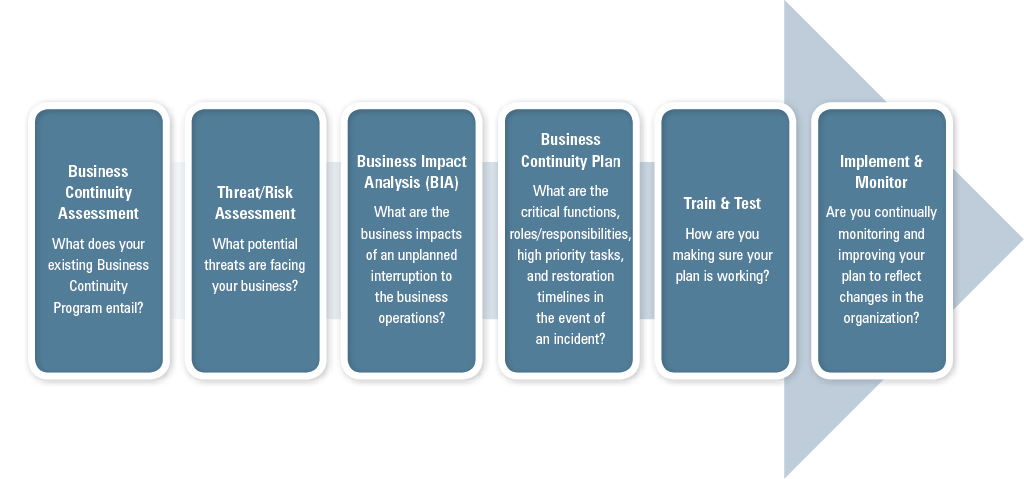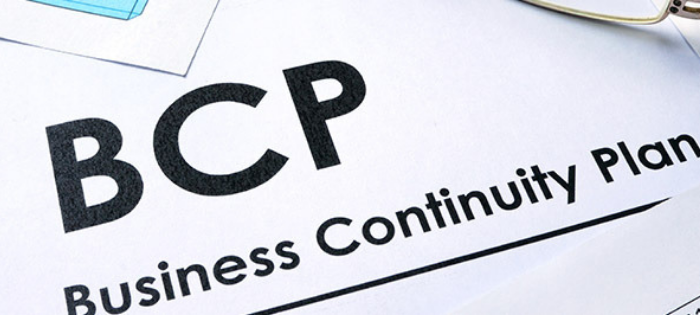
Environment / Quality / Safety
Comments: No Comments
Business Continuity: Building a Resilient Organization
When business is disrupted, the costs can be substantial. Unfortunately, every organization is at risk from potential operational disruptions—natural disasters, fire, sabotage, information technology (IT) viruses, data loss, acts of violence. Recent world events have further challenged organizations to prepare to manage previously unthinkable situations that may threaten the future of the business.
Securing Company Assets
This goes beyond the mere Emergency Response Plan or disaster recovery activities that have been previously implemented. Organizations must now engage in a more comprehensive process to secure their companies’ assets (e.g., people, technology, products, and services). Today’s threats require implementation of an ongoing, interactive process that assures the continuation of the organization’s core business activities and data center(s) before, during, and, most importantly, after a major crisis event.
Creating a Resilient Organization
Business continuity planning helps ensure that companies have the resources and information needed to maintain service, reliability, and resiliency under adverse conditions. While companies can’t plan for everything, they can take steps to understand and effectively manage events that might compromise their products/services, supply chain, quality, security, and future as an organization.
A Business Continuity Plan ensures that all involved parties understand who makes decisions, how the decisions are implemented, and what the roles and responsibilities of participants are when an incident occurs. Through business continuity planning, companies are able to:
- IDENTIFY the human, property, and operational impacts of potential business threats
- EVALUATE the potential severity of associated risks
- ESTIMATE the likelihood of business threats occurring
- CREATE timelines for restoration and strategies that proactively mitigate the most pressing business threats, take advantage of opportunities that lie ahead, and provide for a more resilient and sustainable future
Systematic Approach
A sound Business Continuity Program relies on a systematic approach to identify and critically evaluate risks/opportunities, as outlined below. This approach broadens the scope of issues beyond mere emergency response and allows companies to budget for and secure the necessary resources to support critical business activities before, during, and after a major crisis event. Ultimately, following this process helps companies to stay in business through a time of crisis.
Sustaining Business for the Long Term
Sustainability is about staying in business for the long term, and today, business continuity is key to sustaining business over time. That is because a well-developed and implemented Business Continuity Plan:
- Keeps employees and the community safe when an incident occurs
- Protects the organization’s important assets (e.g., people, technology, products, services)
- Reduces disruption to critical functions in order to limit financial impacts due to loss of product/service
- Reduces adverse publicity, loss of credibility, and loss of customers
- Reduces legal liability and regulatory exposure
- Reduces the risk of losing critical business data (e.g., historical, operational, customer, regulatory compliance)
- Provides for an orderly and timely recovery by allowing critical decisions to be made in a non-crisis mode
- Helps companies mitigate risks and focus on the future
*****
Guiding Standards
ISO 22301: Societal Security – Business Continuity Management Systems is specifically designed to help organizations protect against, reduce the likelihood of occurrence, prepare for, respond to, and recover from disruptive incidents when they arise. Like other ISO standards, ISO 22301 applies the Plan-Do-Check-Act/Adjust model to developing, implementing, and continually improving a Business Continuity Management System. Following this internationally recognized standard allows organizations to leverage their existing management systems and ensure consistency with any other ISO management system standards that may already be in place (e.g., ISO 14001 – environment, ISO 9001 – quality, ISO 45001 – safety, ISO 22000 – food safety).
The American Society for Industrial Security (ASIS) Business Continuity Management System Standard, National Fire Protection Association (NFPA) 1600: Standard on Disaster/Emergency Management and Business Continuity Programs, and Office of the Comptroller of the Currency (OCC) federal banking requirements for business continuity provide further industry-specific guidance on business continuity management.

Environment / Quality / Safety
Comments: No Comments
Using Data Analysis for Business Decisions
Today’s business managers face greater complexities than ever when it comes to making business decisions. For every business decision, there are a number of factors that impact the associated risks. Fortunately, the use of statistics, predictive analytics, and data mining has become increasingly useful in taking the “gut feel” out of making important and often complex business decisions.
Data-Driven Decisions
Most people are familiar with common descriptive statistical techniques, like measures of central tendency (e.g., mean, median, mode) or variability (e.g., interquartile range, standard deviation). More advanced data mining and predictive analytical techniques are increasingly being used to explore and investigate past performance to gain insight for future business decision making.
Data mining draws on large amounts of data to identify patterns, which are often classified as opportunities or risks. Predictive analytics encompasses a variety of statistical techniques that are used to analyze historical data to predict the most probable future events. A few examples of these include the following:
- Discriminant Analysis – a machine learning model where a computer program “learns” a pre-existing data set that includes attributes and outcomes for each individual, and then predicts probable outcomes for individuals in the new data set based on attributes.
- Linear Regression – creates an equation so that one variable can be predicted based on the known values of other variables.
- Logistic Regression – a machine learning model where a computer program “learns” a pre-existing data set that includes attributes and a binary (“yes/no”) outcome for each individual, then predicts “yes/no” outcome for each individual in a new data set, along with a probability associated with the decision.
- Decision trees – machine learning model where a computer program “learns” a pre-existing data set that includes attributes and outcomes (not necessarily binary) for each individual, then predicts outcomes for each individual in a new data set, along with confidence in the decision; also identifies the attributes that are most helpful for making predictions (i.e., those that are best able to discriminate between outcomes).
- Neural networks – similar to decision tree, but more effective if finding the connections between attributes is a concern.
Together, this information can help decision makers to predict the outcome(s) of a decision before it is made—and make smarter decisions based on data instead of gut feelings. The following case studies demonstrate the value that statistics provide when it comes to making important business decisions.
Case Study: Wildfire Risk Index
For a large transportation organization, wildfires have historically presented a unique challenge. The company has worked diligently over the past several years to control its fire risk through research and a number of assessments. To help further minimize the wildfire risk, the company turned to past data and is working with Kestrel to develop a comprehensive Wildfire Risk Index to:
- Quantify the operational risks of wildfires (i.e., identify environmental conditions, determine areas of concern)
- Make informed business decisions to help minimize identified risks
Creating the Index requires a significant amount of data from both internal and external resources, including traffic, weather, geography, internal fire incidents, and others. This information is used in several components contained within two main models that create the Wildfire Risk Index. These model components are relatively simple when used on their own. The complexity arises when combining the various models and their components into a single Wildfire Risk Index that reasonably reflects relative risks, while considering all variables.
The ultimate output of the Wildfire Risk Index is a single number that quantifies the relative risk of wildfire by location and by month. This information will help the company to:
- Identify the areas of greatest risk.
- Focus resources on those areas.
- Make more informed decisions regarding operations—like when to plan hot work and when and where to perform vegetation control—to help prevent future incidents.
Case Study: Incident Data
For a large petroleum refining organization, safety and environmental incidents present a significant risk to operations. In order to reduce incident frequency, the company has implemented a robust safety management system, which includes frequent audits and inspections. Despite the company’s best efforts, however, incidents have continued to occur.
To further improve safety and environmental performance, Kestrel is working with the company to conduct detailed reviews of previous incidents using Kestrel’s proprietary Human Performance Reliability (HPR) approach. This approach identifies and classifies the human factors contributing to incidents, as well as the controls associated with those human factors (engineered, administrative, and/or PPE). Once the reviews are finished, the results are statistically analyzed to generate a prioritized list of human factors to be addressed. Kestrel’s Human Factors Integration Tool (HFIT™) software then generates a list of existing controls associated with the top human factors, as well as a list of missing controls that could be created and implemented.
The ultimate output of the incident review process is to help the company identify the human factors contributing to incidents, create or improve associated controls, manage operational risks, and protect the health and safety of workers and the surrounding environment.
Versatility
These examples demonstrate how predictive analytics can be used to support decision making. The versatility of predictive analytics, combined with the variety of statistical techniques available, can be applied to help companies analyze a wide variety of problems and gain insight for future business decision making.

Drones 101: Tips for Managing Your Drone Program
This is the fifth article in Kestrel’s Drones 101 series.
As we’ve discussed in our Drones 101 series, both large and small companies can establish safe and reliable drone programs; however, lack of planning will (at best) add up to a short-lived drone program or (at worst) cause your company undue risk or injury.
In short, buying and operating UAS equipment without a plan in place can lead to:
- Sunk costs
- Delayed success
- Safety incidents
- Service delays
- Employee injury
- Loss of financial backing legal and regulatory issues
On the flip side, when implemented appropriately, using drones often results in a solution that is:
- Faster – Significantly reduce manhours to complete work (e.g., inspections, audits, monitoring) without requiring plant shutdown.
- Safer — Eliminate the need for humans to complete high-risk activities (e.g., climbing towers, entering confined spaces, inspecting disaster zones).
- More accurate — Gather comprehensive and reliable data with less room for human error and less variability.
Top Tips
Here are Kestrel’s top six tips for managing a successful drone program:
- Establish a plan and budget to accurately track and communicate costs and determine your return on investment.
- Establish standard processes, procedures, and communication protocols to ensure end users, company, and management teams understand expectations and obligations.
- Engage a cross-functional team, which may include program management, field operations, engineering and maintenance, human resources, legal, information technology, etc. to effectively manage all aspects of your UAS program.
- Create a UAS program operations manual that lays out expectations and company-approved applications of UAS technology.
- Set metrics and evaluation methods for the UAS program overall and its impacts on the core business. This will help show the value of your UAS program.
- Follow the classic management system plan-do-check-act cycle to drive continual improvement in not only the drone program, but in the core business, as well.
Learn more about Kestrel’s UAS Program Management services. Be sure to check out the entire Drones 101 series:
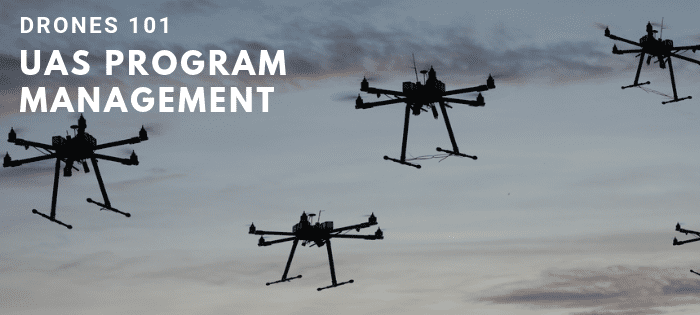
Drones 101: UAS Program Management
This is the fourth article in Kestrel’s Drones 101 series.
Drones can reduce risk in commercial operations, but it is important to acknowledge that they can also introduce risk through damage to property, safety incidents, loss of UAS assets, and legal and regulatory issues. And without a planned, organized UAS program, your risks increase significantly.
Why UAS Programs Fail
Why do some drone programs fail? Both large and small companies can establish safe and reliable drone programs, but a solid foundation early in the process is essential for success. Lack of planning will (at best) add up to a short-lived drone program or (at worst) cause your company undue risk or injury.
In short, buying and operating UAS equipment without a plan in place can lead to:
- Sunk costs
- Delayed success
- Safety incidents
- Service delays
- Employee injury
- Loss of financial backing legal and regulatory issues
Foundations of a Drone Program
A solid, sustainable UAS program starts with consideration of a handful of essential elements, as discussed below.
Financial Resources. Your program needs to consider cost. Not only will you need to create a budget for approval, but you will want to be aware of and able to accurately communicate costs and have a basis for arriving at a return on your investment. A good approach is to categorize your costs into one-time capital costs; recurring costs related to equipment, software and pilots; and costs for expansion.
 Incidentally, the cost to take the Part 107 Airmen Knowledge Test is $150 per attempt. A prep course online will run about $200 -$300. To stay current, pilots are required to take a test every two years, which also costs $150 per attempt
Incidentally, the cost to take the Part 107 Airmen Knowledge Test is $150 per attempt. A prep course online will run about $200 -$300. To stay current, pilots are required to take a test every two years, which also costs $150 per attempt
The key point is to understand your costs, budget for them, and put the drone program in the best position to be funded as needed.
Cross-Functional Strategy
Ideally, you want a team of people with different functional expertise working toward the common goal of helping the company achieve the benefits associated with a drone program. Consider involving individuals in program management, operations management, legal/compliance, human resources, information technology, and others.
Depending on how large your organization is, the team may be one or two individuals who wear many hats and juggle responsibilities. Larger organizations may expand the size and functions beyond this example. Think about how your organization might function:
- Is your program manager and operations manager the same person?
- Which of the following is the highest priority for your legal team: data security, regulatory compliance, or employee safety?
- Do you have the in-house IT resources to support the technical needs of a UAS program?
You don’t necessarily have to have a large team, but you do need to consider how you’ll cover all the related functions and responsibilities.
UAS Program Operations Manual
A UAS program operations manual – whether it is a paper binder or an online resource – is a must. It’s important that you have well thought-out policies and procedures, standard practices, and emergency plans. It is just as important that all your pilots and team members are familiar with them, so everyone is operating from the same playbook.
Your operations manual should lay out expectations and company-approved applications of UAS technology. In general, it should include the following:
- Policies, procedures, standard operating practices, safety programs
- Identified risks, hazards, and emergency situations; mitigation measures
- Data management and documentation requirements
- How/when to verify federal and state regulations for UAS technology
- Employment terms/contracts (employee, contractor, vendor)
Integrated Systems
Much like the cross-functional team we just covered, your internal business systems should include drone program-related tasks and subsystems. These should be integrated into the normal flow of business in your organization.
If your company operates under an ISO-style management system (e.g., ISO 9001, ISO 140001, or ISO 45001), you have the opportunity to align and integrate systems with your existing program and take advantage of the plan-do-check-act cycle associated with ISO management systems. Consider systems for communication, inventory management, data management, employee management, and technical support, among others.
Measurable Goals
It’s a standard exercise in any management system to set measurable goals and track progress against them. The same standard should be upheld for drone program management. Setting metrics and evaluation methods will allow you to show the value of your UAS program.
- First, set goals for the drone program overall. This may include:
- UAS pilot effectiveness (e.g., safety, training status, reportables, compliance)
- Effectiveness of policies and procedures
- ROI of the UAS program (e.g., money saved, time saved, fewer injuries, lower workers compensation rates)
- Second, set goals to measure the impact of the drone program on your core business.
- How will UAS enhancements change/improve existing company performance metrics?
- For example, can you move from biannual inventory of resources to quarterly due to ease of inspections? Or monitor high-risk bridges, wind turbines, etc. every 3 months?
- Set or adjust thresholds based on the knowledge you gain from UAS enhancements.
Plan for Continuous Improvement
Finally, you should have a plan for continuous improvement. An effective plan will follow the classic management system plan-do-check-act cycle to drive improvement in not only the drone program, but in the core business as well.
In the diagram below, drone program goals related to improved policies and procedures lead to standard operations practices. The effectiveness of these actions is evaluated, gaps are identified, and additional goals are set. As an example, let’s say one of those policies and procedures is to address how we manage flight data. A goal is set, the procedure is examined, previously unidentified risks are discovered, and mitigation measures are put in place in the policies, procedures and SOPs.
 Key Takeaways
Key Takeaways
Drones can enhance your current business operations by reducing the time and safety risks involved with routine tasks, but they bring with them their own operational and regulatory considerations. To help ensure your drone program’s success:
- Establish a solid foundation early.
- Establish policies and procedures to reduce inefficiencies and ensure compliance.
- Create systems to reliably track the location, status, and condition of your drone fleet – regardless of size.
- Establish systems to track and manage the training and certification status of all employees or contractors in the UAS program.
- Monitor and manage maintenance and repairs/replacements of the drone fleet to reduce operational risks of drone failure during flight and to ensure that employees are operating their drones safely and efficiently.
- Develop systems to manage and organize huge quantities of data from drone flights so you can easily find footage/stills and leverage the data gathered.
- Design and implement integrated software systems to prevent liabilities, loss of ROI, and safety risks.
Learn more about Kestrel’s UAS Program Management services. Be sure to check out the entire Drones 101 series:
- Terminology & Technology
- Applicability
- Regulations
- Drone Program Management
- Top 6 Tips for Managing Your Drone Program

Drones 101: Regulations for sUAS
This is the third article in Kestrel’s Drones 101 series.
Drone usage is regulated by the Federal Aviation Administration (FAA). In 2016, FAA issued new rules for non-hobbyist (i.e., commercial) small Unmanned Aircraft System (sUAS) operations in 14 CFR Part 107. Part 107 covers a broad spectrum of commercial uses for drones weighing less than 55 pounds at time of takeoff and landing.
Commercial vs. Hobby
For the purposes of Part 107, commercial is considered as anything except recreational or hobby use. Whether you are making money directly with your drone or just using it as a tool within your company, Part 107 applies to drone pilots and drones used for business purposes.
Operating Requirements
Many of the rules in Part 107 are common sense; others are not. This list provides an overview of the operating requirements for complying with Part 107:
- The remote pilot must keep the drone within visual line of sight (VLOS) at all times.
- The operator should always avoid manned aircraft.
- Neither the pilot nor a visual observer can be responsible for more than one sUAS at a time.
- You are only allowed to fly during daylight hours. If you attach the proper anti-collision lighting, you may conduct operations during twilight hours. Night operations are prohibited without proper authorization from the FAA.
- Minimum weather visibility is three miles from your control station.
- Maximum allowable altitude is 400 feet above the ground (higher if your drone remains within 400 feet of a structure, such as when you inspect a tower or tall building).
- Maximum speed is 100 mph (87 knots).
- You cannot fly directly over any people unless they are directly and knowingly involved in the operation.
- You can carry an external load if it is securely attached, does not adversely affect the flight characteristics or controllability of the aircraft, and maintains the weight limit of 55 lbs. at time of takeoff and landing.
- The National Airspace System is divided into several categorizations and it is imperative that all UAS operators know and understand the various airspace designations.
- Operations in Class A are prohibited unless authorizations from the FAA are secured and the operators coordinate their operation through air traffic control. sUAS operations in Class A airspace is extremely unlikely due to the altitude.
- Class B and Class C airspace designations surround all major and minor airports. Operations in Class B and Class C airspace require prior authorization from the FAA, which can be difficult to obtain. Certain exceptions are made and, in the event that operations are approved in either of these airspaces, coordination with air traffic control and/or airport operator is required.
- Class E airspace resides between the top limits of all the other airspace designations and the bottom of Class A airspace. Class E airspace can also be found around non-towered airports with instrument approach requirements and can require air traffic control or airport operations coordination during hours when the tower is operational. This varies, and operators should refer to their sectional maps and flight planning tools before every flight to verify their current airspace requirements.
- Class G airspace does not require any additional approvals for operations; a majority of commercial UAS operations occur within these areas.
- Airspace designations can change, and temporary flight restrictions are frequently established for various reasons. Operators should always refer to their sectional maps and flight planning tools before, during, and after all UAS operations.
You can request a Certificate of Waiver from certain Part 107 regulations, and/or authorization to operate in restricted airspace by submitting a request directly to the FAA. There are tools that can help with this process, but waiver requests can be complicated, and most are not approved by the FAA. Kestrel can help you write effective waivers.
Low Altitude and Notification Capability (LAANC)
For access to restricted airspaces that are at low altitudes (under 400 feet), operators can use a new tool recently released by the FAA referred to as LAANC (Low Altitude Authorization and Notification Capability). LAANC aims to provide near real-time airspace authorizations for UAS operations under Part 107.
LAANC automates the application and approval process for airspace authorizations at nearly 300 air traffic facilities covering approximately 500 airports. It dramatically decreases the wait time experienced with the manual authorization process, provides greater flexibility in operational planning, and directly supports UAS integration into the airspace.
Pilot Certification
To operate a sUAS under Part 107, pilots need a remote pilot airman certificate with a small UAS rating or must be under the direct supervision of a person who holds such a certificate. This certification entails passing a two-hour Airmen Knowledge Test to become certified, and then applying for your certificate online, which includes passing a TSA background check. Operators must retake the Airmen Knowledge Test every two years to stay current.
If you already have a Part 61 pilot certificate, other than a student pilot certificate, you must have completed a flight review in the previous 24 months and you must take a sUAS online training course provided by the FAA. Pilots receive a certificate of completion, which must be renewed every 24 months.
If you are acting as pilot in command, you must:
- Make your drone available to the FAA for inspection or testing on request, and provide any associated records required to be kept under the rule.
- Report to the FAA within 10 days any operation that results in serious injury, loss of consciousness, or property damage (to property other than the UAS) of at least $500.
Drone laws and regulations are constantly evolving as the industry evolves.
. As an example of the ever evolving regulations, effective February 25, 2019 the FAA now requires that all sUAS display their aircraft registration number on an external surface of the aircraft. This rule was established under 14 CFR Part 48. Additional rules regarding night operations and flights over people are in the proposed rule phase and are expected to become effective by the end of April. In addition, record retention laws are forthcoming for drone footage and may vary by state.
Not surprisingly, pilots can unknowingly (and easily) violate FAA regulations. One very important task as part of your overall UAS program management strategy should be to keep current on pilot certifications, drone registrations, and regulatory changes to remain compliant.
Learn more about Kestrel’s UAS Program Management services. Be sure to check out the entire Drones 101 series:
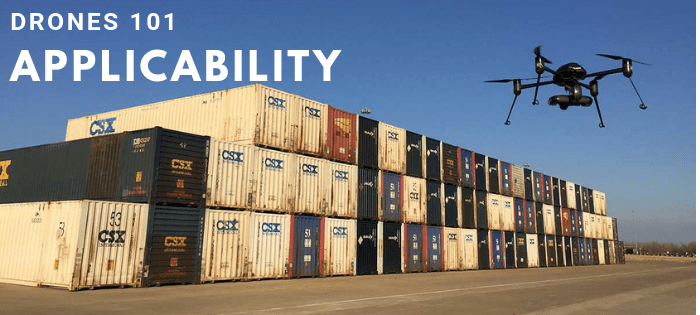
Drones 101: Applicability
This is the second article in Kestrel’s Drones 101 series.
As we move into this important new phase of everyday use of drone technology in the workplace, some questions may arise:
- How many drones are there operating in commercial space?
- Where are they being used?
- How are they being used to help operations?
Commercial Drone Operation
The chart below illustrates actual data from FAA’s aerospace forecast from this year. It highlights the phenomenal growth in drone use. The FAA projects that the commercial drone fleet is set to grow from over 110,000 in 2017 to over 450,000 by 2022 using its base, or most likely numbers. FAA’s high-end estimate predicts over 700,000 commercial drones in use by 2022. The number of remote pilots (indicated by the blue dotted line) is set to increase from 73,673 in 2017 to over 301,000 by 2022.
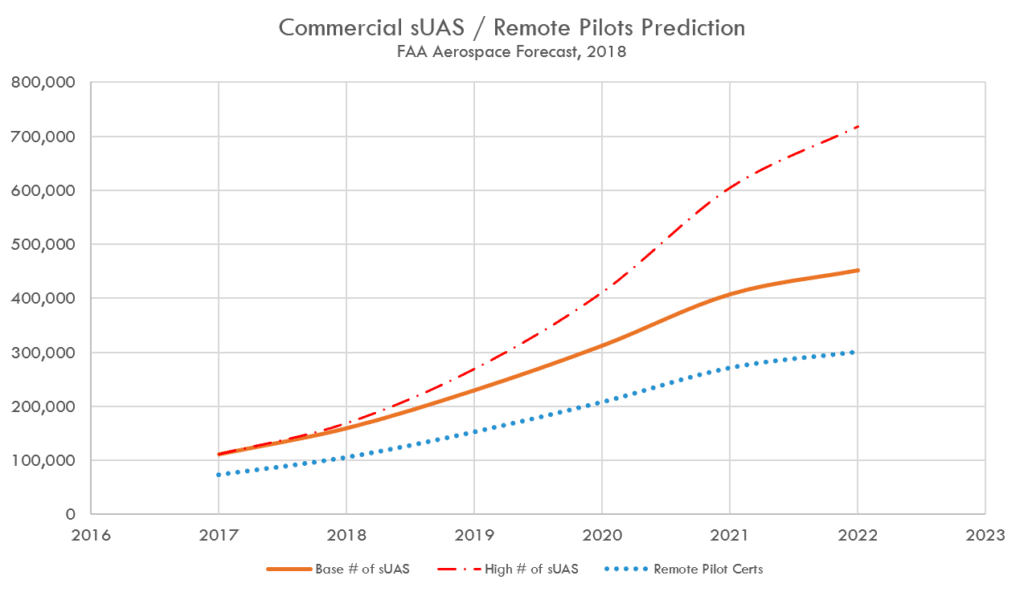 Further, the map below shows the distribution of registered commercial drones in the U.S. in 2017. The larger dots indicate a higher number of drones registered in that area. From this information you can see that commercial drones are popular and in use all over the country, not just in isolated pockets.
Further, the map below shows the distribution of registered commercial drones in the U.S. in 2017. The larger dots indicate a higher number of drones registered in that area. From this information you can see that commercial drones are popular and in use all over the country, not just in isolated pockets.
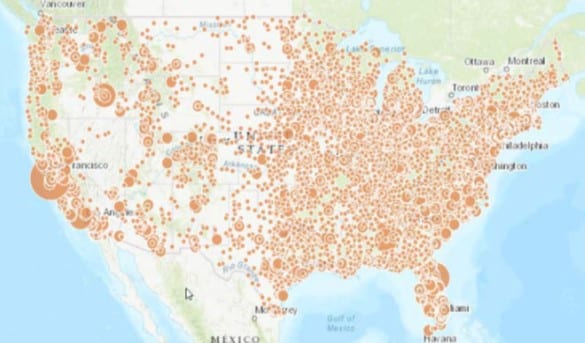 Typical Uses of Commercial sUAS
Typical Uses of Commercial sUAS
This pie chart from the FAA shows in a general sense how commercial drones are being used in the U.S. By far the most common use is aerial photography and mapping, followed by industrial inspection and agriculture. Insurance and state & local governments round out the chart. Construction is not represented separately on this chart, but it has been identified as the fastest growing industry segment in terms of drone use.
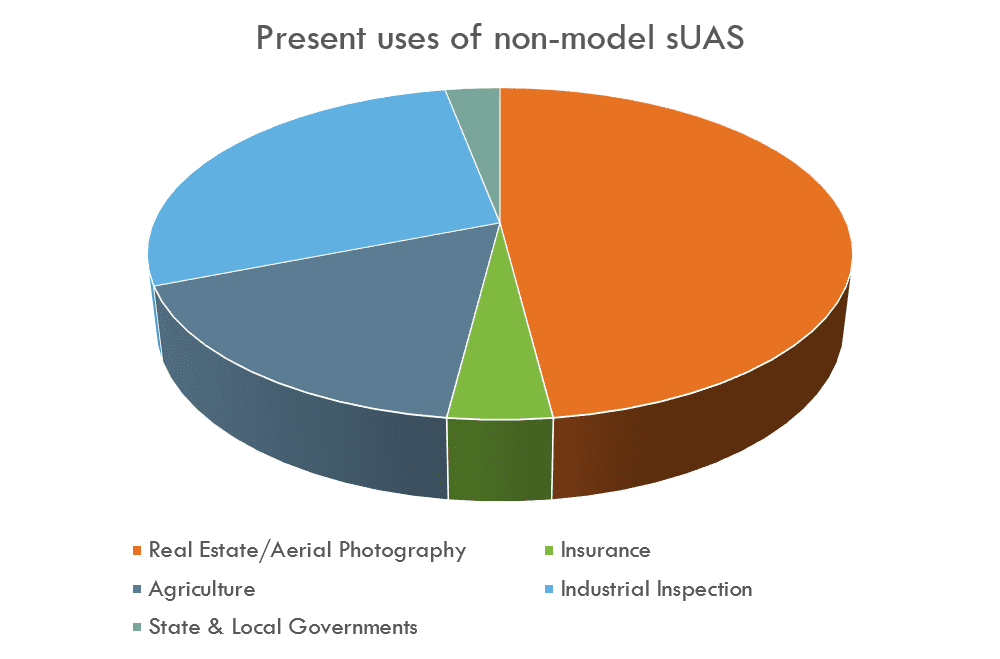 Why Drones?
Why Drones?
Using drones in commercial settings can clearly save time and money in many different ways, including the following:
- Outputs from drone applications can provide support, such as 3D modeling of existing facilities, evidence for insurance or legal claims, or cause-finding efforts for incident investigations.
- Drones can also be used to objectively monitor changes over time, such as erosion control, flood rise and water damage, or the rate of deterioration of fixed outdoor assets like tanks and towers.
- Sensors and software designed for drones offer quick, convenient means to measure stockpile volumes and inventories, evaluate flood plains, or quantify spills.
- Data captured can be used proactively to anticipate environmental risks, indicate preventive maintenance needs, or inform everyday decision-making.
- Drones can quickly and accurately determine stockpile volumes, which is very useful in the mining and aggregate industries.
- Finally, one of the most important uses of drones is to reduce employee exposure to hazardous conditions. These might include working at heights, confined spaces, or any situation where there is a risk of injury or death.
Drone Applications in Action
Let’s take a look at two examples of drones in action.
Application 1: Cause Finding.
Drones are being used across various industries to enhance cause-finding efforts. These tools are especially useful when hazardous materials or conditions are involved, and when the assets involved are on fire, at height, or pose a high safety risk to those involved.
One example of this is railroad derailment prevention. Standard derailment prevention operations involve derailment cause-finding efforts, such as interviewing those involved, walking the site and taking photos by hand and at eye-level. Derailment sites for large Class I railroads can be well over a mile long and can include spilled hazardous materials or active fires depending on the severity of the incident. Inspecting these sites can be time consuming, risky and, since these events are always unplanned, they can be disruptive to those involved.
Using drones, companies have been able to fly a derailment site in a fraction of the time it would have taken a person or persons to walk the entire site. With a LiDAR unit attached to the drone, companies scan the site and, using the data points generated during data collection efforts, recreate the accident scene to scale back at home base. This technology allows for more advanced analytics to be run on the incident. By recreating the accident scene using the data gathered by the drone and an appropriate software package, companies have been able to pinpoint the exact reasons that a train has derailed.
In one such instance, a company was able to determine that one of its trains was loaded in such a way that the push and pull being placed on the couplers was stressed to the point of breakage after the train went over and down a section of undulating territory at a certain speed. The company was able to analyze the degree of the undulation, the relative age of the coupler(s) involved, and the exact moment and location of the derailment. By digitally reconstructing the scene, they could see exactly which part of the train began to wobble, why it became unsteady and what caused the trajectory observed at the derailment site. With the application of UAS technology, the company was able to turn these detailed insights into multiple proactive and response mitigation actions.
Application 2: Industrial Inspection.
Drones are being used at processing and manufacturing plants to identify faults and aid in predicting required maintenance on equipment. In certain applications, specially designed drones are flown into hazardous and confined spaces instead of sending workers in.
One example of the latter is the periodic internal inspection of a large industrial boiler at a mine in Utah. Typically, this is accomplished by installing scaffolding down the middle of the boiler so that a team of technicians can climb down and observe specific features looking for cracking and signs of wear. What is normally a week-long process is now done in half a day with a confined space drone, and literally saves hundreds of thousands of dollars, because production is shut down for hours instead of days.
At another tank farm, UAS operators set waypoints to fly the same route periodically to check for irregularities and deterioration on the tanks, as well as evidence of releases from tanks and piping. This allows for proactive repairs and more efficient maintenance efforts. With a thermal imaging camera attached to the drone, the operator can perform a rough visual level check on the tanks to confirm that individual level sensors on the tanks are performing as expected, so that product inventories are accurate.
Enhancing Operations
There are many ways that drones can be used to enhance operations, regardless of industry. Drones offer a tool to access and assess physical conditions, minimize risks, and enhance employee efficiency during job tasks that are otherwise routine/time consuming, difficult to accomplish (i.e., have a high safety risk, exposure to hazardous materials that could result in injury or death), challenging to reach/excessively large (i.e., working at heights or in confined spaces), or time-sensitive.
When implemented appropriately, using drones often results in a solution that is:
- Faster – Significantly reduce manhours to complete work (e.g., inspections, audits, monitoring) without requiring plant shutdown.
- Safer — Eliminate the need for humans to complete high-risk activities (e.g., climbing towers, entering confined spaces, inspecting disaster zones).
- More accurate — Gather comprehensive and reliable data with less room for human error and less variability.
Learn more about Kestrel’s UAS Program Management services. Be sure to check out the entire Drones 101 series:
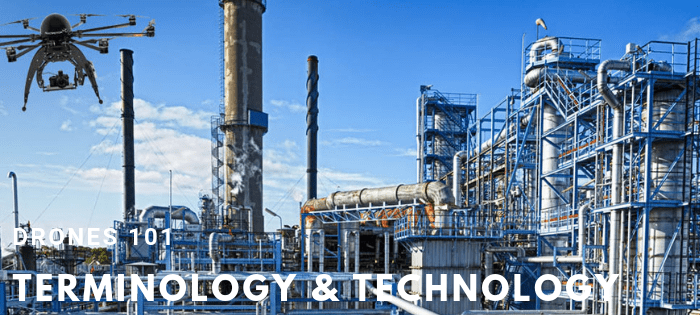
Drones 101: Terminology & Technology
This is the first article in Kestrel’s Drones 101 series.
Industries like transportation, manufacturing, utilities, mining, construction, oil and gas, and agriculture are crucial to our country’s infrastructure, particularly in a rapidly changing global market. Yet these industrial sectors continually face the challenges of an aging workforce and high-risk job tasks, including exposure to moving freight cars, high-voltage transmission lines, and hazmat materials and risks of slips, trips, falls, maiming and premature death.
Emerging Technology
Fortunately, drones are an emerging technology that offers a solution both to the shrinking workforce and as an additional mitigation tactic for various operational safety needs of heavy industries.
What was once a very niche market, drones are emerging into an important new phase: everyday use of drone technology in the workplace. It’s no longer just tech-savvy companies that are using drones. Enterprise-level Unmanned Aerial System (UAS) operations are becoming a big deal in industry. Organizations ranging from municipalities and agriculture companies to the Fortune 500s are getting involved in drone operations.
In another three to five years, it will potentially make business sense for nearly every major industrial company to incorporate UAS technologies into their operations for two reasons:
- Drones are effective at both mitigating risks and increasing operational efficiency.
- Drones are a tool that can bolster workforce recruitment and retention efforts.
Terminology & Technology
As drones become more popular and the industry continues to grow, newer and more varied versions of them are hitting the market, making it difficult to keep up with the technology and the related terminology.
If you’ve observed or read anything about drones, you may have noticed a few acronyms thrown around, and that can be a little confusing. Some of the most common terminology includes the following:
- Drone is used to define just about any type of Unmanned Aerial Vehicle (UAV). The term refers to many different types of an unmanned aircraft of various sizes, which are used for multiple functions, ranging from armed forces aircraft to hobbyists taking amateur digital photography.
- Unmanned Aerial Vehicle (UAV) refers to the platform, airframe, or body of the craft you are flying. The term can be used interchangeably with drone.
- Unmanned Aerial System (UAS) includes the vehicle or aircraft, the controller, and the link(s) that connect them. A small Unmanned Aerial System (sUAS) is a UAS weighing less than 55 pounds at takeoff and landing.
It is best practice to use UAS in formal documents like policies and procedures. If you have a diverse approach that includes both light and heavy drones, then specifying whether a document pertains to sUAS or UAS operations would be optimal, as the regulations vary based on weight, and your operational policies and procedures would need to reflect this.
Types of UAS
While there are variety of drone technologies on the market, the three main types of UAS available in the commercial space are the following:
- Multi-rotor UAS is the most popular drone type for both commercial use and for hobbyists. This type of drone is typically less difficult to operate. They offer vertical take-off and landing and the ability to hover, both of which can result in highly detailed data points and targeted insights. Quad-, hexa-, and octo-copters are all available (i.e., 4, 6 or 8 rotors). There are a number of typical use cases of multi-rotor drones, including industrial inspections, aerial mapping, site planning and monitoring, cause finding, resource management, crop spraying and many more.
- Fixed-wing UAS function more like an airplane than their multi-rotor counterpart. These drones often resemble small airplanes or mechanical stingrays. They consist of two fixed wings on either side of the craft. This design provides for more efficient aerodynamics and longer flight times (~45-60 min per flight). Fixed-wing have high aerial coverage (up to 2,400 acres per flight) but offer less detailed imagery, are typically unable to hover, and are more suited for covering large areas of land, resulting in large data sets with less detail than you would collect using a multi-rotor or a hybrid UAS. These drones require a suitable runway area for takeoff and landings and are usually able to carry heavier payloads than other types of UAS. Typical uses include beyond visual line of sight (BVLOS) operations, photogrammetry and 3D mapping, crop inspections, and other tasks that require significant area coverage.
- Hybrid UAS are gaining popularity, as these platforms offer the benefits of a vertical takeoff and landing and the ability to fly quickly in a forward motion to cover larger areas of land, while still having the ability to hover. Hovering allows for close-up inspections and produces more detailed information than a quick fly by. Hybrids range in their load carrying capability. Hybrids can be used in many of the same ways as fixed wings and multi-rotors but are most excitingly known for their use in delivery services and unmanned air taxi applications.
Payloads
In addition to the drone itself, there are many types of payloads, which is a generic term for the cameras, sensors, or other equipment that can be attached to and carried by drones:
- Specialized cameras are the most often used payloads for drones.
- Various cameras offer the ability to gather higher resolution images with greater detail.
- LiDAR units can be attached to gather data points from any work site, which can then be translated into 3D-modeling efforts to aid in volumetric applications.
- Thermal/infrared cameras provide heat sensing capability.
- Gas detection cameras detect fugitive gas leaks at pipelines and tanks.
- Multispectral and hyperspectral sensors are electromagnetic energy sensors that offer insight into details on resources that would otherwise be invisible to the human eye.
- Environmental sensors (e.g., chemical sensors) can measure chemical compositions and traces of particular chemical substances, including radioactive particles and particulate matter.
Undoubtedly, the types of drones and the payloads will continue to expand as the market and applicability of drones continues to grow.
Learn more about Kestrel’s UAS Program Management services. Stay tuned for the rest of our Drones 101 series, featuring:
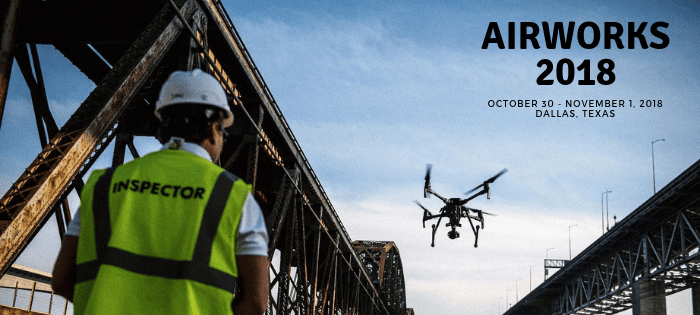
Comments: No Comments
Kestrel to Present at AirWorks 2018
The AirWorks 2018 Conference is focused on the growing commercial drone industry and how developers, partners, and operators can work to reshape the global economy with drones. This year, Kestrel Management will be teaming with Union Pacific Railroad to talk about our experience and lessons learned from managing industrial-scale drone programs.
AirWorks 2018
October 30 – November 1, 2018
Dallas, Texas

Kestrel Presentation: Bringing Your Drone Program to Scale: Lessons Learned from Going Big
Thursday, November 1 at 11:00 a.m.
Rachel Mulholland, Kestrel Management Consultant, Industrial UAS Programs
Edward Adelman, Union Pacific Railroad, General Director of Safety
This presentation will discuss the risks and opportunities associated with building an industrial drone program and share some of the lessons learned from our experience. We’ll discuss common questions, including the following:
- What does it take to build an industrial drone program?
- How can UAS technology fit into your current business model?
- What challenges can occur with fleets of certified remote pilots and unmanned vehicles?
- How do you ensure you operate in compliance with FAA regulations?
- What are some common pitfalls to avoid and best practices to incorporate into your program?
Why You Should Attend
If you currently have a drone program or are looking to implement one, this event is for you!
- Attend sessions focused on the industry track most relevant to your business: construction, energy, agriculture, public safety, infrastructure
- Network with companies that are on the forefront of enterprise drone adoption
- Get a preview of the latest drone technologies
- Receive hands-on training from experienced industry leaders and instructors

USTR Finalizes China 301 List 3 Tariffs
On Monday, September 17, 2018, the Office of the United States Trade Representative (USTR) released a list of approximately $200 billion worth of Chinese imports, including hundreds of chemicals, that will be subject to additional tariffs. The additional tariffs will be effective starting September 24, 2018, and initially will be in the amount of 10 percent. Starting January 1, 2019, the level of the additional tariffs will increase to 25 percent.
In the final list, the administration also removed nearly 300 items, but the Administration did not provide a specific list of products excluded. Included among the products removed from the proposed list are certain consumer electronics products, such as smart watches and Bluetooth devices; certain chemical inputs for manufactured goods, textiles and agriculture; certain health and safety products such as bicycle helmets, and child safety furniture such as car seats and playpens.
Individual companies may want to review the list to determine the status of Harmonized Tariff Schedule (HTS) codes of interest.

Assessing Risk Management Program Maturity
Maturity assessments are designed to tell an organization where it stands in a defined area and, correspondingly, what it needs to do in the future to improve its systems and processes to meet the organization’s needs and expectations. Maturity assessments expose the strengths and weaknesses within an organization (or a program), and provide a roadmap for ongoing improvements.
Holistic Assessments
A thorough program maturity assessment involves building on a standard gap analysis to conduct a holistic evaluation of the existing program, including data review, interviews with key staff, and functional/field observations and validation.
Based on Kestrel’s experience, evaluating program maturity is best done by measuring the program’s structure and design, as well as the program’s implementation consistency across the organization. For the most part, a program’s design remains relatively unchanging, unless internal modifications are made to the system. Because of this static nature, a “snapshot” provides a reasonable assessment of the design maturity. While the design helps to inform operational effectiveness, the implementation/operational maturity model assesses how completely and consistently the program is functioning throughout the organization (i.e., how the program is designed to work vs. how it is working in practice).
Design Maturity
A design maturity model helps to evaluate strategies and policies, practices and procedures, organization and people, information for decision making, and systems and data according to the following levels of maturity:
- Level 1: Initial (crisis management) – Lack of alignment within the organization; undefined policies, goals, and objectives; poorly defined roles; lack of effective training; erratic program or project performance; lack of standardization in tools.
- Level 2: Repeatable (reactive management) – Limited alignment within the organization; lagging policies and plans; seldom known business impacts of actions; inconsistent company operations across functions; culture not focused on process; ineffective risk management; few useful program or project management and controls tools.
- Level 3: Defined (project management) – Moderate alignment across the organization; consistent plans and policies; formal change management system; somewhat defined and documented processes; moderate role clarity; proactive management for individual projects; standardized status reporting; data integrity may still be questionable.
- Level 4: Managed (program management) – Alignment across organization; consistent plans and policies; goals and objectives are known at all levels; process-oriented culture; formal processes with adequate documentation; strategies and forecasts inform processes; well-understood roles; metrics and controls applied to most processes; audits used for process improvements; good data integrity; programs, processes, and performance reviewed regularly.
- Level 5: Optimized (managing excellence) – Alignment from top to bottom of organization; business forecasts and plans guide activity; company culture is evident across the organization; risk management is structured and proactive; process-centered structure; focus on continuous improvement, training, coaching, mentoring; audits for continual improvement; emphasis on “best-in-class” methods.
A gap analysis can help compare the actual program components against best practice standards, as defined by the organization. At this point, assessment questions and criteria should be specifically tuned to assess the degree to which:
- Hazards and risks are identified, sized, and assessed
- Existing controls are adequate and effective
- Plans are in place to address risks not adequately covered by existing controls
- Plans and controls are resourced and implemented
- Controls are documented and operationalized across applicable functions and work units
- Personnel know and understand the controls and expectations and are engaged in their design and improvement
- Controls are being monitored with appropriate metrics and compliance assurance
- Deficiencies are being addressed by corrective/preventive action
- Processes, controls, and performance are being reviewed by management for continual improvement
- Changed conditions are continually recognized and new risks identified and addressed
Implementation/Operational Maturity
The logical next step in the maturity assessment involves shifting focus from the program’s design to a maturity model that measures how well the program is operationalized, as well as the consistency of implementation across the entire organization. This is a measurement of how effectively the design (program static component) has enabled the desired, consistent practice (program dynamic component) within and across the company.
Under this model, the stage of maturity (i.e., initial, implementation in process, fully functional) is assessed in the following areas:
- Adequacy and effectiveness: demonstration of established processes and procedures with clarity of roles and responsibilities for managing key functions, addressing significant risks, and achieving performance requirements across operations
- Consistency: demonstration that established processes and procedures are fully applied and used across all applicable parts of the organization to achieve performance requirements
- Sustainability: demonstration of an established and ongoing method of review of performance indicators, processes, procedures, and practices in-place for the purpose of identifying and implementing measures to achieve continuing improvement of performance
This approach relies heavily on operational validation and seeking objective evidence of implementation maturity by performing functional and field observations and interviews across a representative sample of operations, including contractors.
Cultural Component
Performance within an organization is the combined result of culture, operational systems/controls, and human performance. Culture involves leadership, shared beliefs, expectations, attitudes, and policy about the desired behavior within a specific company. To some degree, culture alone can drive performance. However, without operational systems and controls, the effects of culture are limited and ultimately will not be sustained. Similarly, operational systems/controls (e.g., management processes, systems, and procedures) can improve performance, but these effects also are limited without the reinforcement of a strong culture. A robust culture with employee engagement, an effective management system, and appropriate and consistent human performance are equally critical.
A culture assessment incorporates an assessment of culture and program implementation status by performing interviews and surveys up, down, and across a representative sample of the company’s operations. Observations of company operations (field/facility/functional) should be done to verify and validate.
A culture assessment should evaluate key attributes of successful programs, including:
- Leadership
- Vision & Values
- Goals, Policies & Initiatives
- Organization & Structure
- Employee Engagement, Behaviors & Communications
- Resource Allocation & Performance Management
- Systems, Standards & Processes
- Metrics & Reporting
- Continually Learning Organization
- Audits & Assurance
Assessment and Evaluation
Data from document review, interviews, surveys, and field observations are then aggregated, analyzed, and evaluated. Identifying program gaps and issues enables a comparison of what must be improved or developed/added to what already exists. This information is often organized into the following categories:
- Policy and strategy refinements
- Process and procedure improvements
- Organizational and resource requirements
- Information for decision making
- Systems and data requirements
- Culture enhancement and development
From this information, it becomes possible to identify recommendations for program improvements. These recommendations should be integrated into a strategic action plan that outlines the long-term program vision, proposed activities, project sequencing, and milestones. The highest priority actions should be identified and planned to establish a foundation for continual improvement, and allow for a more proactive means of managing risks and program performance.

